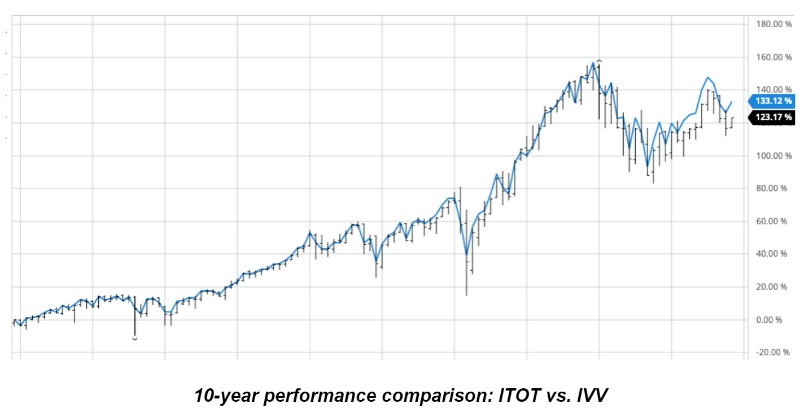 By Eric Rosenberg, WCI Contributor
By Eric Rosenberg, WCI ContributorWhen investing in iShares Exchange Traded Funds (ETFs), you’ll likely encounter two diverse index funds with similar profiles. ITOT is the ticker symbol for the iShares Core S&P Total US Stock Market ETF, while IVV is the iShares Core S&P 500 ETF. Both ETFs feature the same low 0.03% expense ratio, but one maintains about five times the number of stocks in its fund. Here’s a deep dive comparing ITOT vs. IVV to help you understand how they may fit into your portfolio and investment strategy.
What Is an iShares ETF?
iShares is one of the most prominent ETF fund families in the world. Owned and managed by BlackRock, iShares offers more than 1,200 funds focused on stocks, fixed income, commodities, real estate, and various investment goals.
According to iShares data, the funds are held by 120 million investors with $2.5 trillion in assets under management. New funds come into the iShares fund family periodically. In the fall of 2023, for example, it added target date ETFs. These are the first target date funds available as ETFs rather than mutual funds
ETFs are excellent for meeting short-term to long-term investment goals. As diversified equity funds, ITOT and IVV are well-suited for longer-term investments. Keep a close eye on management fees, which tend to be relatively low when you choose iShares index funds. Top competitors include ETFs and mutual funds from Fidelity, Charles Schwab, Vanguard, State Street (SPDR), and Invesco (among others).
If you’re new to mutual funds and ETFs, learn more from this guide on How Do You Evaluate and Compare Mutual Funds and Exchange Traded Funds?
What Is ITOT?
ITOT is the iShares Core S&P Total US Stock Market ETF. As the name suggests, the fund offers exposure to many stocks representing similar performance to the entire US stock market. It includes stocks ranging from small to large cap across the major US stock exchanges.
The ITOT fund follows the S&P Total Market Index, and it includes 2,640 stocks. As of this writing, the fund holds more than $48 billion in assets. Top holdings include Microsoft, Apple, Amazon, NVIDIA, Google, Meta (Facebook), Berkshire Hathaway, and other familiar brands.
With an ultra-low 0.03% expense ratio, ITOT is one of the least expensive diversified stock market investment funds in existence (the Vanguard equivalent fund also has a 0.03% expense ratio, while Fidelity boasts an expense ratio of 0.015%). These are all prices that are tough to beat. The portfolio managers reinvest dividends to increase the fund’s yield. ITOT earns a three-star rating from Morningstar and a Gold Medalist rating.
More information here:
ITOT vs. VOO: Which S&P 500 Index Fund Is Best?
What Is IVV?
IVV is the iShares Core S&P 500 ETF. Again, the name does a good job of explaining the fund. It follows the 500 stocks in the S&P 500 index. The S&P 500 index comprises 500 of the biggest public companies in the United States. While it only has 500 stocks, its performance is extremely similar to the total stock market fund.
As of this writing, the fund owns 507 stocks. Investors have poured $394 billion into the fund, making it the second-largest ETF, only smaller than the State Street SPDR S&P 500 fund. Its market cap is weighted to the largest stocks, and it has an identical set of top holdings, including Microsoft, Apple, Amazon, NVIDIA, Google, Meta, and Berkshire Hathaway.
It comes with a 0.03% expense ratio. Again, that’s a tough price to beat. It’s a five-star rated fund by Morningstar with a Gold Medal rating. It’s a top-rated fund and a standout in its class. Dividends are reinvested to keep the fund in balance while boosting fund performance.
ITOT vs. IVV: Which Should I Choose?
ITOT and IVV generally feature similar performance and identical expense ratios. That can make it tricky to know which to choose. Both are diversified index fundsfollowing the overall performance of the stock market.

Due to its weighting toward the largest stocks, IVV performance has been better for all periods from the last month to the last 20 years, as of this writing. ITOT is better when comparing both funds since inception, though they were started a few years apart. That said, performance is very similar, with only a tiny margin difference between the two over most periods.
For what it's worth, here's how they performed in 2023: ITOT was 28.75%, and IVV was 28.61%.
In most cases, you won’t go wrong with either fund. They feature similar performance net of fees, and either could be a cornerstone of your portfolio. The S&P 500 index has outperformed the S&P total market index over the last couple of decades, so you may want to lean in that direction. However, there’s no guarantee that performance will continue in the future.
More information here:
FXAIX vs. VOO: Which Index Fund Is Best?
ITOT vs. IVV: Which Is Better?
When asking which is better, the answer is almost too close to call. I’ll lean slightly toward IVV, as the top 500 stocks have performed better in recent years. However, buying a portfolio of 2,600 stocks doesn’t yield significantly different returns than a portfolio of the 500 biggest. In fact, the entire S&P 500 list is part of the total stock market, so you get exposure to IVV when buying ITOT.
If I were investing today, I’d probably lean toward IVV over ITOT, but it doesn’t have to be an all-or-nothing prospect. I might go 75% IVV and 25% ITOT, or 80/20, or 60/40, or another combination. With similar performance, splitting up your investments adds a small additional level of diversification. But when you’re already buying at least 500 stocks, both funds come built in with diversification—and at a bargain price.
Do you prefer ITOT or IVV? Why? Do you prefer investing with BlackRock instead of with brokerages like Vanguard, Schwab, or Fidelity?
